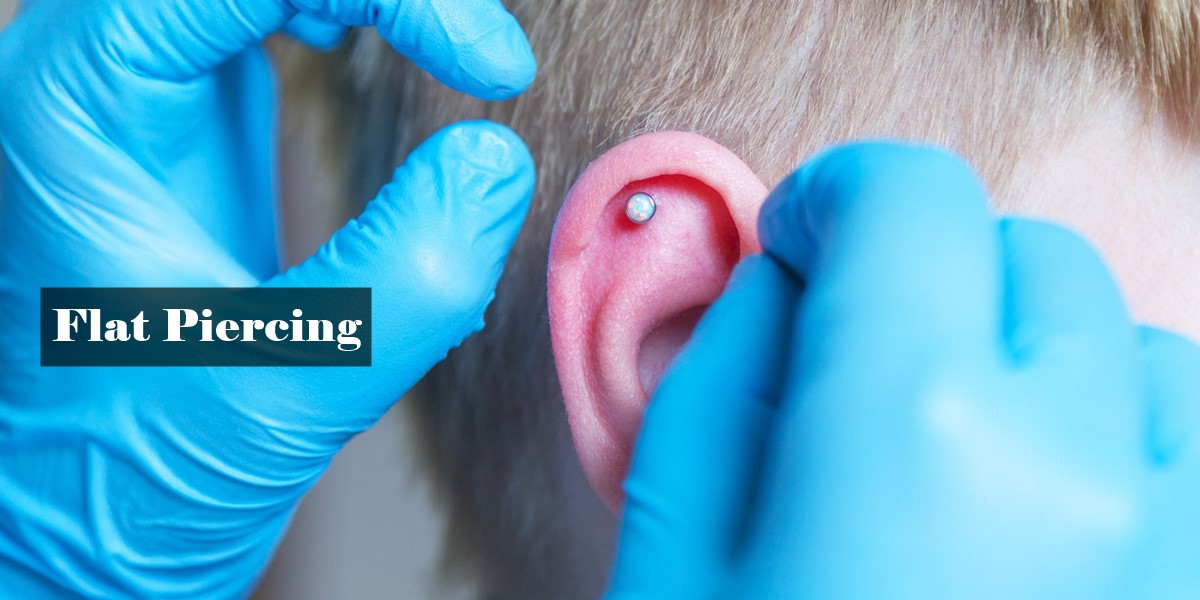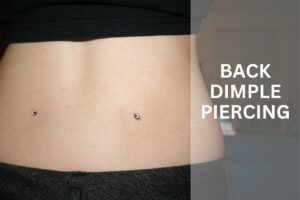In the ever-evolving landscape of modern fashion, cartilage piercings have undeniably risen as the must-have accessory of the 2020s. Embracing the beauty of ear cartilage, this trend offers a unique canvas for self-expression, allowing individuals to explore a plethora of piercing options. Whether you seek a cultivated look that reflects your favorite constellation or crave an eclectic style adorned with beautiful cartilage jewelry, flat piercing emerges as a captivating choice to elevate your ear ensemble.
With its distinctive placement on the flat area of the ear’s cartilage, the flat piercing has become the newest addition to the cartilage party. This particular style perfectly complements the modern fashion scene, where unique and chic piercings are celebrated. As fashion enthusiasts explore their individuality, the flat piercing stands out as a must-try accessory, adding a touch of elegance and personality to their overall appearance.
Incorporating a flat piercing into your existing cartilage piercings can be a delightful struggle. The process of choosing the ideal piercing placement becomes an exciting journey, with the ear serving as a fascinating playground for creative expression. A carefully curated arrangement of piercings, each with its own charm and significance, allows fashion enthusiasts to showcase their favorites while creating a harmonious and stylish ensemble.
When it comes to cartilage piercings, the possibilities seem endless. Each piercing becomes a meaningful addition, reflecting personal favorites and passions. Embrace the love for fashion and the joy of self-expression as you fill your ears with beautiful and thoughtfully chosen cartilage jewelry.
What Exactly Is A Flat Piercing?
Flat piercing is a captivating and stylish form of cartilage piercing that has gained immense popularity in recent years. The unique piercing placement on the upper rim of the ear, known as the helix, or the flap of cartilage where the rook is located, offers a vast canvas for creative expression. It’s a wonderful option for those seeking to adorn their ears with a distinctive and personalized touch.
One of the fascinating aspects of flat piercing is its versatility. It can be combined beautifully with other cartilage piercings like the forward helix or auricle, creating an intricate and harmonious ear ensemble. The forward helix, situated at the front of the ear, and the auricle, forming the outer portion, perfectly complement the flat piercing, adding depth and character to the overall look.
While flat piercing enhances the aesthetics of the ear, it’s essential to be mindful of the healing process. Cartilage heals differently than fleshier areas, requiring extra care and patience. The healing time may take longer due to its avascular nature, where blood flow is limited. Understanding this essential part of the healing process is crucial before committing to a flat piercing.
To ensure a successful and comfortable experience, it is necessary to know how to care for the piercing during the entire healing process. Proper aftercare, such as keeping the area clean and avoiding unnecessary touching, plays an integral role in the overall healing journey.
How Painful Is A Flat Piercing?
When it comes to cartilage piercings, the flat piercing stands out as a captivating and trendy choice.
Understanding pain concerns is vital when considering piercings. Pain levels can vary due to several factors, particularly concerning cartilage thickness. Thinner cartilage tends to be more sensitive, leading to the flat piercing registering higher on the pain scale compared to other types of piercings. However, it’s essential to note that pain tolerance varies among individuals, and having a low pain tolerance doesn’t prevent you from getting a flat piercing.
To ensure a positive piercing experience, selecting the right piercer is crucial. An experienced piercer will guide you through the entire procedure, providing valuable information and ensuring your comfort throughout. Their expertise plays a significant role in minimizing pain and ensuring a smooth process overall.
They will guide you on when to breathe, and their swift execution ensures that the piercing is done quickly and efficiently.
Prior preparation is also vital to ensure a smooth and comfortable procedure. Make sure to eat and drink water before the appointment to give your body the necessary energy. Your piercer’s skill and attention to detail greatly impact the success of your flat piercing, so choose wisely.
How Long Does A Flat Piercing Take To Heal?
The healing journey of a flat piercing is essential and requires careful consideration and commitment to proper aftercare practices. A flat piercing generally takes around 6 months to fully heal, but in some cases, it might require up to one year. For a smooth healing process, it’s crucial to follow the advice of a skilled piercer and maintain proper care of your body during this period.
Proper aftercare practices are crucial for shortening the healing duration of a flat piercing. Ensure enough rest for your body and avoid touching or interfering with the piercing site to promote healing. Leaving the jewelry undisturbed is equally important as it minimizes the risk of trauma, which could prolong the healing process.
Keep in mind that a flat piercing may appear healed before it is fully done healing. To be sure, seek confirmation from a piercer before changing jewelry or stopping aftercare practices. Consulting with a professional piercer ensures that the piercing is fully healed and reduces the likelihood of complications from premature changes.
Commitment is the key to a successful flat piercing experience. By dedicating yourself to proper aftercare, giving your body the rest it needs, and seeking guidance from an experienced piercer, you can ensure that your flat piercing heals beautifully and in a timely manner. While the healing process may require patience, the stunning result of a fully healed flat piercing makes the journey worthwhile. With the right approach, you can enjoy your stylish and personalized ear adornment for years to come.
Flat Piercing Aftercare
Cartilage piercings, like any other, require proper aftercare to avoid infection and promote healing. Healing times for flat piercings may vary, but with diligent aftercare, you can minimize any potential side effects, such as piercing bumps or scars.
- Use saline solution or a homemade sea salt solution to clean the piercing 2-3 times daily for effective aftercare.
- The use of a fine mist piercing aftercare spray on the front and back of the piercing can keep your flat piercing clean and aid in the healing process.
- Prevent hypertrophic scarring by avoiding jewelry snags on hair or clothing, refraining from rotating the jewelry, and not picking at crusties around the piercing.
- Consult with your piercer about switching to a smaller jewelry piece if you feel that your current one is too large after the initial swelling subsides.
- Use products specifically safe for piercings to prevent chemical irritants that may lead to complications like hypertrophic scarring.
- Keep face wash, lotion, sunscreen, shampoo, and other products away from the piercing area to avoid any potential irritation.
- After showering, ensure you thoroughly rinse and dry your flat piercing immediately to maintain cleanliness and support healing.
What Jewelry Should I Wear In My Flat Piercing?
A flat piercing offers a versatile canvas for expressing individuality and style with various jewelry options. Cartilage studs with bead backs or flat backs provide a secure and comfortable fit for the piercing. For those seeking a touch of elegance, charming gemstones and dangles can be added to the cartilage studs, creating an adorable and unique look.
Choosing the right jewelry materials is essential for a successful flat piercing experience. Titanium is commonly chosen as starter jewelry because of its affordability and hypoallergenic nature. It is an excellent option for individuals with sensitive skin as it contains minimal alloys. During the initial healing phase, the jewelry piece is slightly larger to accommodate swelling. However, after approximately a week, a professional piercer can replace it with a smaller piece for a more comfortable fit.
Once the initial swelling has gone down, nickel-free 14k gold emerges as a favorable option. It strikes a balance between durability and aesthetics, making it suitable for daily use without tarnishing quickly. The distinct difference between high-quality gold and cheaper jewelry materials is evident to even a layman, showcasing the allure of 14k gold.
For a safe and comfortable experience, proper care is of utmost importance. Avoiding the use of jewelry with alloys helps prevent potential irritation or complications.
Why Shouldn’t I Get A Flat Piercing?
Flat piercing, a type of cartilage piercing, requires proper aftercare and commitment throughout the healing process. The cartilage piercings take a relatively long time to heal due to their avascular nature, making them more susceptible to infection.
Cartilage piercings may require more time and attention, but the results are worth it.
For individuals with health problems or a tendency to get sick easily, it’s crucial to keep the potential infection risk in mind. However, this should not discourage you from getting a flat piercing.
How Much Does A Flat Piercing Cost?
For flat piercing, budget around $40 – $80, excluding the cost of the jewelry.
It’s crucial to select a reputable piercer for a safe and successful experience. Avoid piercers using piercing guns, as they can be harmful, particularly for cartilage piercings due to their brittle nature.
Opt for high-quality, hypoallergenic metals when choosing your initial jewelry. Popular options include 14k gold and implant-grade titanium. If you experience irritation in your new piercing, consult your piercer about switching to a higher quality metal to avoid allergic reactions to alloys.
What’s The Difference Between A Flat Piercing And A Shen Men Piercing?
Let’s clear up the confusion between flat piercings and Shen men piercings:
Flat piercings and Shen men piercings might seem similar, but they have some key differences. The Shen men piercing combines a flat piercing with a conch piercing, specifically placed in the flap of cartilage between the rim of your ear and the flap of cartilage above your ear canal. It mimics the appearance of a rook piercing when your ear anatomy isn’t suitable for one.
The Shen men piercing doesn’t necessarily include the conch piercing; it can be just the flat piercing above the rook cartilage. If you ask for a Shen men piercing, it will be placed in this specific area, but asking for a flat piercing gives you more placement options.
It’s essential to know that the Shen men piercing is believed to have acupuncture-like benefits for reducing anxiety. However, there is no scientific evidence to support this claim, and we don’t recommend piercings as a solution for addressing mental health concerns. Always prioritize your well-being and consult a healthcare professional for any mental health needs.
Different Types Of Flat Piercings
When deciding on a flat piercing, the placement options can offer plenty of creative choices. Take into account the size of the area where you want the piercing and consider the potential for future piercings, like a double- or triple-flat piercing.
One appealing option is a triple flat piercing, where three close-fitted flat piercings form a triangle. Another delightful idea is to use the space for a constellation piercing, creating a super cute and unique look. The possibilities for your flat piercing are almost limitless, so explore and find the perfect style that suits you best.







